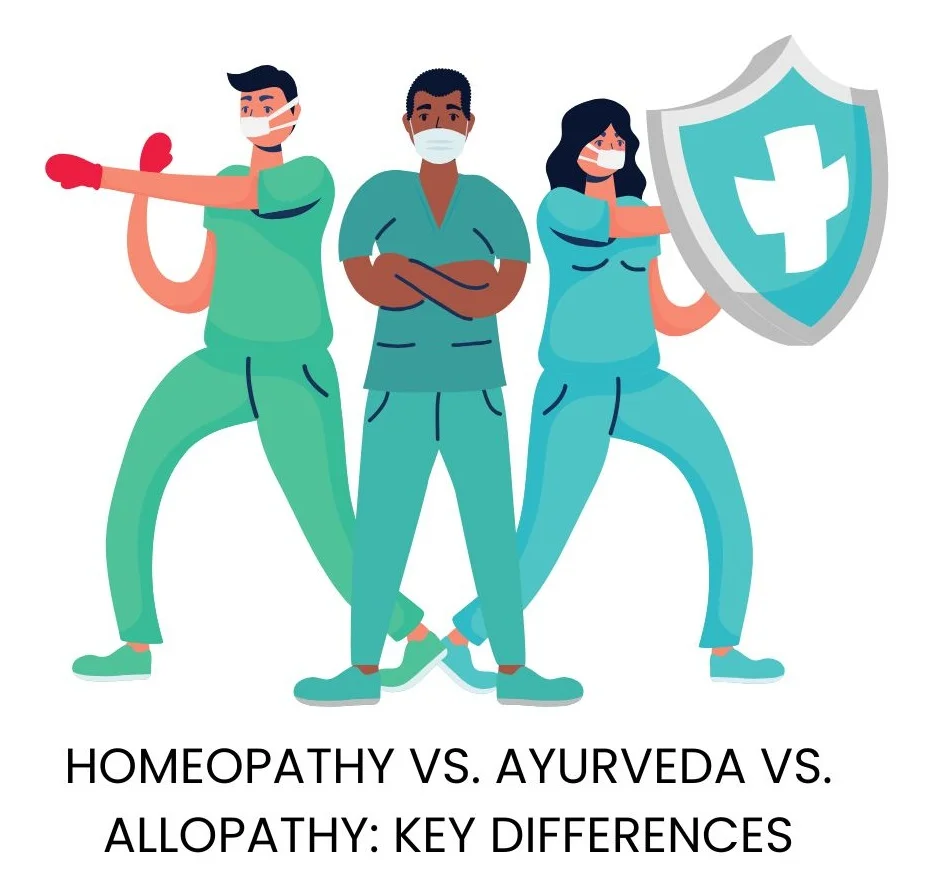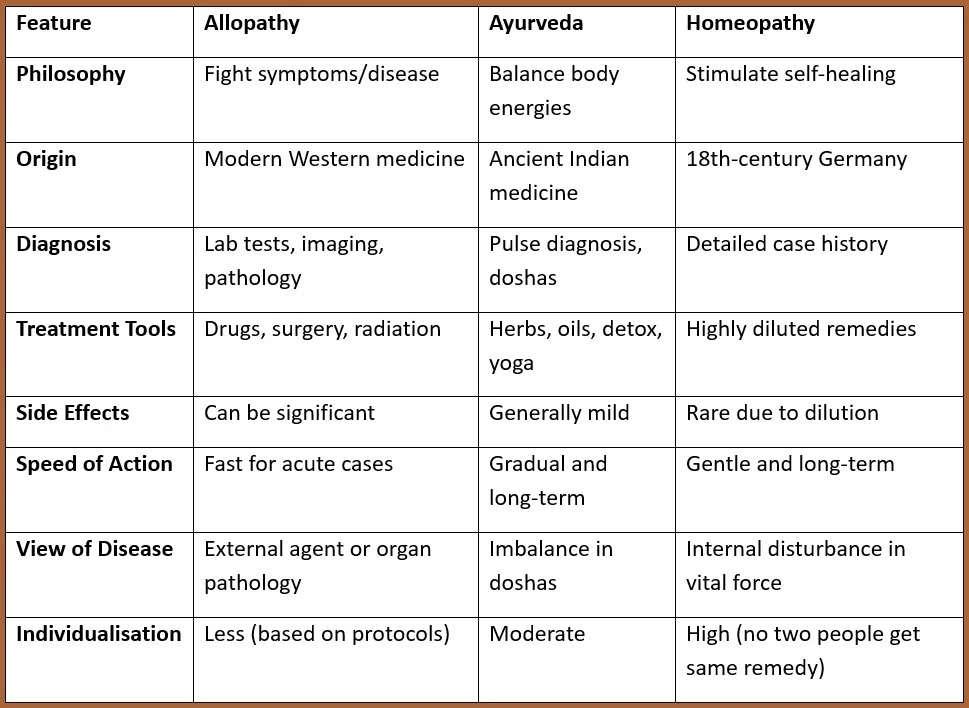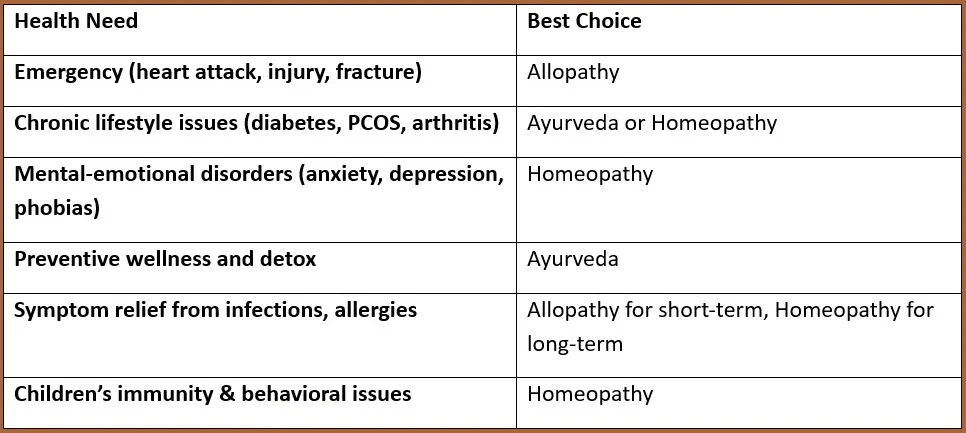In the world of healing and healthcare, patients today are presented with more choices than ever. Among the most commonly discussed and practiced systems of medicine are Homeopathy, Ayurveda, and Allopathy.
Each of these systems offers a different philosophy, approach to disease, and methods of treatment.
But how do they really differ? Which one is better? Which one should you choose?
Whether you’re a curious patient, a parent seeking holistic remedies, a healthcare student, or someone exploring alternatives to conventional medicine — this blog is for you.
Let’s break down the key differences between Homeopathy, Ayurveda, and Allopathy in a simple, clear, and unbiased way, so you can make informed choices for your health.
HOMEOPATHY VS. AYURVEDA: WHICH ONE WORKS BEST FOR CHRONIC ILLNESS?
HOMEOPATHY VS. ALLOPATHY: CAN THEY WORK TOGETHER FOR BETTER HEALTH?
ALLOPATHY VS HOMEOPATHY: WHICH IS BETTER?
COMBINING HOMEOPATHY WITH AYURVEDA FOR WOMEN’S HEALTH: A HOLISTIC APPROACH TO HEALING

What Are These Three Systems of Medicine?
Allopathy (Conventional Medicine)
Also known as modern medicine or Western medicine, Allopathy is the mainstream system most people are familiar with.
It includes doctors, hospitals, surgeries, diagnostic tests, and pharmaceutical drugs.
- Founded by: Hippocrates is known as the “Father of Medicine”, but Allopathy became dominant in the 19th and 20th centuries.
- Main Approach: Treats diseases using opposite forces – for example, using antacids for acidity, antibiotics for infection, or antidepressants for depression.
- Focus: Targets symptoms and aims to remove them quickly and effectively.
Ayurveda (The Science of Life)
Ayurveda is an ancient Indian system of medicine, dating back over 5,000 years. It is deeply rooted in nature, balance, and the rhythms of life.
- Founded by: Ancient Indian sages; documented in texts like the Charaka Samhita and Sushruta Samhita.
- Main Approach: Treats based on doshas (Vata, Pitta, Kapha) and restoring balance.
- Focus: Prevention and long-term wellness using herbs, diet, detox, yoga, and lifestyle changes.
Homeopathy (Like Cures Like)
Homeopathy is a gentle, holistic system of medicine based on the principle of similia similibus curentur — like cures like.
- Founded by: Dr. Samuel Hahnemann, a German physician, in the late 1700s.
- Main Approach: A substance that causes symptoms in a healthy person can cure similar symptoms in a sick person — if highly diluted.
- Focus: Individualized treatment aimed at triggering the body’s natural healing ability.
Key Differences at a Glance

Deeper Dive into Each System
🔬 Allopathy: Strengths & Limitations
✅ Strengths
- Excellent for emergencies, trauma, surgeries, and infections.
- Rapid relief from symptoms.
- Evidence-based with precise diagnostics.
❌ Limitations
- Often focuses on managing symptoms, not root cause.
- Side effects from long-term drug use.
- Doesn’t usually consider emotional or spiritual health.
- Over-reliance on medication.
🌿 Ayurveda: Strengths & Limitations
✅ Strengths
- Treats the root cause by restoring balance.
- Emphasizes prevention and lifestyle correction.
- Uses natural, plant-based remedies and therapies.
- Personalised according to body type (Prakriti).
❌ Limitations
- Can take time to show results.
- Quality and standardization of herbal products can vary.
- Requires strong patient discipline in diet and lifestyle.
- Less emergency care suitability.
💧 Homeopathy: Strengths & Limitations
✅ Strengths
- Completely non-toxic and safe for all ages.
- Focuses on the whole person — mind, body, and energy.
- Strongly individualized — even two people with the same disease may get different remedies.
- Minimal side effects when correctly prescribed.
❌ Limitations
- Can be slow in acute, critical situations.
- Results depend heavily on the skill of the practitioner.
- Often misunderstood and debated due to ultra-diluted doses.
- Not suitable as a standalone for surgical or advanced organ damage cases.
How Do They View Disease?
🩺 Allopathy
Disease is often seen as an invasion by pathogens or a breakdown of body parts.
Treatment is directed at eliminating or controlling the problem externally — through drugs, surgery, or interventions.
🌿 Ayurveda
Disease is due to an imbalance of the doshas, often caused by poor lifestyle, diet, and habits.
Restoration of balance through detox, herbal medicine, and routine is key.
💧 Homeopathy
Disease is a disorder of the vital force, the life energy within.
A matching remedy nudges the body back into self-healing.
When to Choose Which System?

Can They Work Together?
Yes — many integrative doctors now combine systems for holistic healing. For example:
- Using Allopathy for immediate infection control
- Following up with Homeopathy for constitutional support
- Adding Ayurveda for detox and lifestyle balance
The key is coordination and open-mindedness, both from the practitioner and the patient.
FAQs
❓ Is Homeopathy slower than Allopathy?
It depends. For chronic conditions, Homeopathy aims for a deeper and longer-lasting healing, though the pace may be gentler.
❓ Can Ayurveda and Homeopathy be taken together?
Yes, if done under guidance. However, it’s best not to mix too many systems without understanding interactions.
❓ Which is more scientific?
Allopathy has the most structured research system currently.
But both Ayurveda and Homeopathy are evolving with increasing clinical research support.
❓ Can I switch from Allopathy to Homeopathy?
Yes, but consult a qualified practitioner.
Don’t stop allopathic meds suddenly without guidance.
Final Thoughts: You Are the Decision-Maker
Every system has strengths and gaps.
Choosing the right approach depends on:
- Your health goals
- The type of condition
- Your response to treatments
- Your belief system
Whether you resonate with the precision of Allopathy, the depth of Ayurveda, or the gentle healing of Homeopathy — the power is in informed choice.
In the end, true healing is not about systems. It’s about you.
Want to Share Your Experience?
Have you been treated with Homeopathy, Ayurveda, or Allopathy?
Share your journey in the comments — your story might help someone make a better health choice today.
